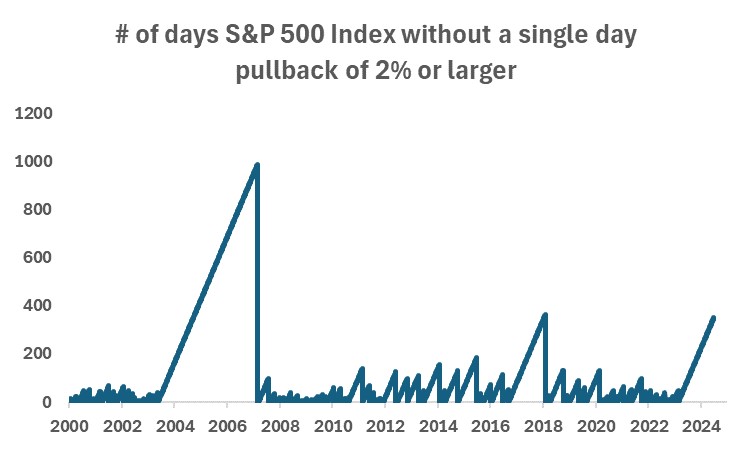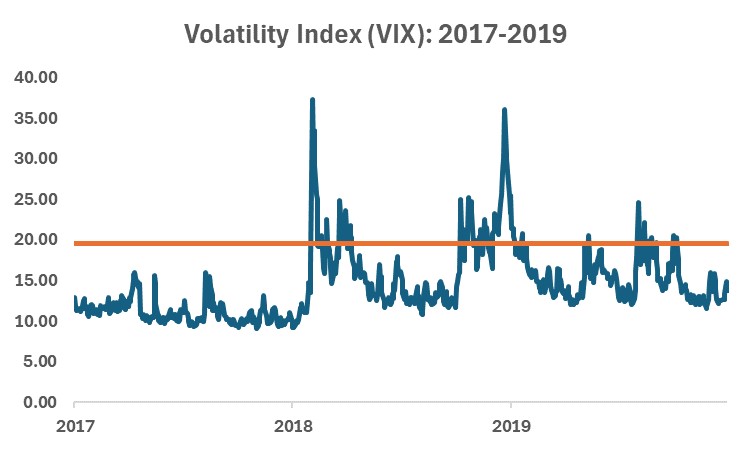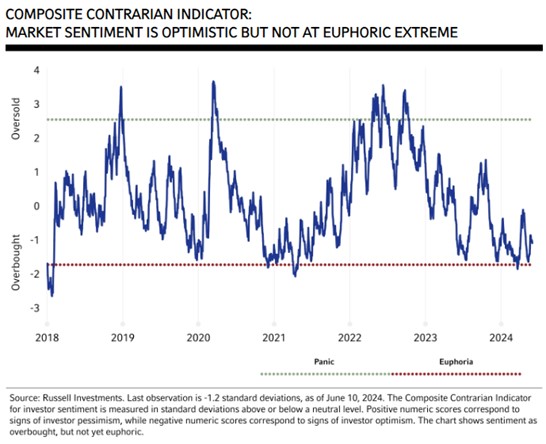Executive summary:
- U.S. equity markets are in a period of extended calm, with the benchmark S&P 500 Index closing in on one year since it last dropped 2% in a single day.
- An extended period of calm means investors must be vigilant and not become complacent. However, it's not necessarily a harbinger of an impending volatility event.
- Our cycle, valuation, and sentiment investing framework does not suggest that an uptick in volatility is imminent.
Parents with young children can relate to the fear that grips us when there's been an extended period of calm or silence in the home—surely, the kids are up to something! Now, my son is in college, and my daughter will be next year, so the sources of our anxieties have shifted a bit. But still, a recent story on CNBC1 about the lack of downside movement in the equity market caught my attention and got me thinking: should we be worried by this extended calm?
The story discussed how the S&P 500 Index has not experienced a single-day correction of more than 2% in quite some time. I recreated a chart similar to the one featured in the article. Chart 1 shows this analysis, and what's notable is that the S&P 500 Index has not declined by 2% or more for 351 days, approaching the prior period of calm that lasted 364 days and preceded the volatility flash crash, colloquially referred to as the Volmageddon event in early February 2018.
Chart 1

Source: LSEG DataStream. Data as of June 26, 2024. S&P 500 price index used to measure daily movements.
The 2018 volatility episode is instructive, as it was preceded by a period of relative calm in 2017 that had market participants positioning for below-average equity volatility to persist. Chart 2 shows the VIX Index, a proxy for equity market volatility, was trading around 10, below the long-term average of 19.5 for most of 2017. However, as volatility started bubbling up, many traders were caught on the wrong side of the volatility bet. Ultimately, volatility bookended 2018, early in the year due to the Volmageddon event, and late in 2018 due to investors' rising anxieties around the U.S. Federal Reserve’s (Fed) rate increases, which eventually led to Fed Chairman Jerome Powell's now famous Powell pivot.
Chart 2

Source: St. Louis Federal Reserve FRED database. Orange line representing the VIX Index long term average is based on the period from January 1990 to June 2024
What’s driving today’s low-volatility market environment?
Information from our equity trading desk suggests that today's low volatility environment has a couple of underpinnings. First, realized volatility has been very low, partly due to the low implied correlation of the Magnificent Seven—the drivers of recent performance—relative to the rest of the equity market, whose performance has been uninspiring. Second, the low uptake of downside management implies investor complacency.
An extended period of calm doesn’t necessarily signal impending volatility
Crucially, an extended period of calm means investors must be vigilant and not get complacent; however, it's not necessarily a harbinger of an impending volatility event. Look again at Chart 1. What stands out is the more extended period of calm—965 days to be exact—from 2003 to 2007. Are markets somewhere in the middle of the 2003 to 2007 episode, which implies there is more runway, or is the current environment more like early 2018? That is anyone's guess. However, we can turn to our cycle-value-sentiment framework to gauge if we should be concerned.
What does our cycle, valuation, and sentiment framework suggest about the market outlook?
Starting with the business cycle, we believe the U.S. economy is not showing imminent signs of a recession that would trigger a severe equity market downturn, which is the primary concern for investors. For instance, the latest Atlanta Fed GDPNowcast for second-quarter gross domestic product (GDP) indicates an expected growth rate of 2.2%. Admittedly, the Nowcast is prone to revisions, but other economic indicators, like labor market trends, improving corporate earnings outlook, and CEO confidence, suggest growth is likely positive over the coming quarters. Still, the business cycle outlook is not without risks. For instance, consumer trends are moderating, and the housing market has notably slowed down due to high financing rates. Therefore, recession risks are elevated relative to historical norms. Nevertheless, recession is not our central forecast. While we expect growth trends to moderate over the coming year, a recession could be avoided, and a soft landing could be achieved. However, the Federal Reserve's commencement of rate cuts this year is essential for this to play out.
While we are constructive about the outlook, U.S. equity valuations concern us. Chart 3 shows that the Shiller price-to-earnings (PE) ratio for U.S. equities is near cycle highs and has only been higher during the dot-com era. However, as John Maynard Keynes famously quipped, the market can stay irrational longer than you can remain solvent. Therefore, while we’re keeping an eye on valuations—particularly what they imply about long-term return potential—over a tactical horizon, high valuations don't point to an imminent drawdown in equities.
Chart 3

Source: Robert Shiller, TradingView. Data as of June 26, 2024.Source: Robert Shiller, TradingView. Data as of June 26, 2024.
We are paying closer attention to sentiment at the moment. Our sentiment analysis gives us a sense of market psychology, whether investors are panicked or euphoric. It serves as a contrarian signal in our process. For instance, if equity sentiment becomes oversold due to excessive pessimism, our process has us leaning into risk. Conversely, if equities are overbought, it's a sign of excessive optimism, and vigilance is critical. Essentially, our sentiment process is designed to quantitatively assess Warren Buffett's adage of being greedy when others are fearful and fearful when others are greedy. Chart 4 shows that market sentiment is leaning toward overbought but not at the extreme euphoric stage that would concern us. Markets are up more than down, so the bar is high to go risk-off in our process.
The bottom line
In summary, the business cycle is expected to moderate but not become recessionary, equities are expensive, and market sentiment is leaning toward overbought conditions but not excessively so. Therefore, our process doesn't suggest imminent downside volatility that warrants risk-off positioning. Still, it underscores the need for vigilance and staying close to one's strategic asset allocation. It could be worthwhile for institutional investors to consider how options-based downside management strategies as a type of insurance against an equity market correction might fit in a total portfolio context. Think of it this way: buying home insurance is cheaper when the house isn't on fire. In that sense, the benign volatility environment has lowered the insurance cost.
So, while the children may be unnervingly quiet, perhaps they are simply pacified watching their favorite cartoon. What happens after the cartoon ends, well, that's anyone's guess. But having another favorite cartoon in the queue could be a good insurance policy.
Our recently released third-quarter Global Market Outlook provides a more detailed analysis of the financial markets and the global economy.
1 Source: https://www.cnbc.com/2024/06/21/stocks-are-in-their-longest-stretch-without-a-2percent-sell-off-since-the-financial-crisis.html

